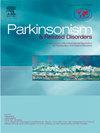揭示亚洲和欧洲患者原发性家族性脑钙化的独特临床表现:一项基于10年个体水平数据的研究。
IF 3.1
3区 医学
Q2 CLINICAL NEUROLOGY
引用次数: 0
摘要
背景:原发性家族性脑钙化(PFBC)在临床上表现为一系列复杂且异质性的症状,包括帕金森症、构音障碍和认知障碍。然而,PFBC在亚洲和欧洲人群中的不同表现仍不清楚。方法:我们对PubMed中涉及基因证实的PFBC患者的研究进行了系统检索。提取每个病例的人口统计资料、遗传信息、放射学检查和临床特征。结果:该研究包括120篇出版物和564例基因证实的PFBC患者。亚洲和欧洲PFBC人群分别占全球患者的54%和37%。虽然钙化模式在亚洲和欧洲PFBC患者之间没有显着差异,但与亚洲患者相比,欧洲常染色体显性PFBC变异携带者更有可能表现出临床症状(OR = 2.90, 95% CI 1.55-5.60),并且估计发病年龄更早(中位年龄42岁对58岁)。结论:区域差异和基因决定的钙化严重程度之间的相互作用可能共同影响PFBC症状的进展。未来的研究应进一步探讨基因修饰剂、种族背景、社会经济和环境暴露因素在PFBC进展地区差异中的潜在作用。本文章由计算机程序翻译,如有差异,请以英文原文为准。
Unveiling distinct clinical manifestations of primary familial brain calcifications in Asian and European patients: A study based on 10-year individual-level data
Background
Primary Familial Brain Calcification (PFBC) can manifest clinically with a complex and heterogeneous array of symptoms, including parkinsonism, dysarthria, and cognitive impairment. However, the distinct presentations of PFBC in Asian and European populations remain unclear.
Methods
We conducted a systematic search of PubMed for studies involving genetically confirmed PFBC patients. Demographic data, genetic information, radiological examinations, and clinical characteristics were extracted for each case.
Results
The study included 120 publications and 564 genetically confirmed PFBC patients. Asian and European PFBC populations represented 54 % and 37 % of global patients, respectively. While calcification patterns showed no significant differences between Asian and European PFBC patients, European autosomal dominant PFBC variant carriers were more likely to exhibit clinical symptoms compared to their Asian counterparts (OR = 2.90, 95 % CI 1.55–5.60) and had an earlier estimated age of onset (median age 42 vs 58).
Conclusion
The interaction between regional differences and genetically determined calcification severity may collectively influence PFBC symptom progression. Future research should further explore the potential roles of gene modifiers, ethnic background, socioeconomic and environmental exposure factors underlying regional differences in PFBC progression.
求助全文
通过发布文献求助,成功后即可免费获取论文全文。
去求助
来源期刊

Parkinsonism & related disorders
医学-临床神经学
CiteScore
6.20
自引率
4.90%
发文量
292
审稿时长
39 days
期刊介绍:
Parkinsonism & Related Disorders publishes the results of basic and clinical research contributing to the understanding, diagnosis and treatment of all neurodegenerative syndromes in which Parkinsonism, Essential Tremor or related movement disorders may be a feature. Regular features will include: Review Articles, Point of View articles, Full-length Articles, Short Communications, Case Reports and Letter to the Editor.
 求助内容:
求助内容: 应助结果提醒方式:
应助结果提醒方式:


